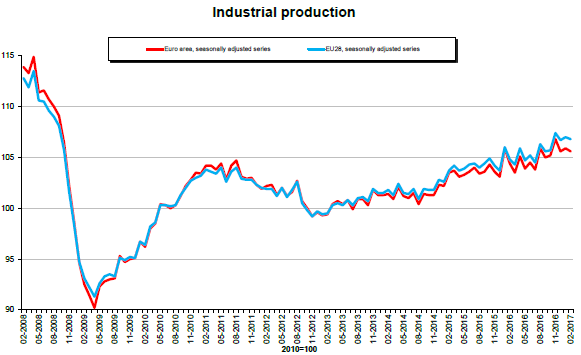Karadi, Peter, (2017), “The ECB’s announcements of non-standard measures and longer-term inflation expectations”, European Central Bank Research Bulletin No. 33, 18 April Stable and well-anchored longer-term inflation expectations bolster the ability of the European Central Bank (ECB) to achieve its medium-term inflation objective. This article assesses the effectiveness of non-standard monetary policy measures in guiding longer-term inflation expectations in an environment where standard interest rate policy approaches the lower bound. …Read More
Annual inflation down to 1.5 % in the euro area
Eurostat/Annual inflation down to 1.5 % in the euro area/19 April2017 Euro area annual inflation was 1.5% in March 2017, down from 2.0% in February. In March 2016 the rate was 00.0%. European Union annual inflation was 1.6% in March 2017, down from 2.0% in February. A year earlier the rate was 0.0%. These figures come from Eurostat, the statistical office of the European Union. Relevant Posts Eurostat/Euro area annual …Read More
Business investment rate up to 23.5% in the euro area
Eurostat/Business investment rate up to 23.5% in the euro area/12 April 2017 In the fourth quarter of 2016, the business investment rate was 23.5% in the euro area, compared with 22.0% in the previous quarter. The business profit share in the euro area was 42.0% in the fourth quarter of 2016, compared with 40.7% in the third quarter of 2016. Relevant Posts Eurostat/Business investment rate up to 22.2% in the …Read More
Household saving rate down to 12.0 % in the euro area
Eurostat/Household saving rate down to 12.0 % in the euro area/12 April 2017 The household saving rate in the euro area was 12.0% in the fourth quarter of 2016, compared with 12.3% in the third quarter of 2016. The household investment rate in the euro area was 8.5% in the fourth quarter of 2016, compared with 8.6% in the previous quarter. Relevant Posts Eurostat/Household saving rate up to 12.8% in …Read More
The Global Crisis and regional employment in Europe: The performance of sheltered economies
Fratesi, Ugo, Rodriguez-Pose, Andres, (2017), “The Global Crisis and regional employment in Europe: The performance of sheltered economies”, VoxEU, 16 April Prior to the Great Recession, many European regions witnessed the emergence of economies which were impervious to changes in the business cycle (or ‘sheltered’ economies). We know little about how such regions coped with the Global Crisis. This column argues that regions with more sheltered economies performed worse in …Read More
Home sweet home: the home bias in trade in the European Union
Mika, Alina, (2017), “Home sweet home: the home bias in trade in the European Union”, ECB Working Paper Series No 2046, April The aim of the paper is to answer the following question: do European Union countries trade domestically more than they would trade with their itnernaitonal clones? While this question may appear somewhat hypothetical, it is useful in understanding how much borders between countries hinder trade flows. To answer …Read More
Subsidiarity: The forgotten concept at the core of Europe’s existential crisis
Danthine, J. P., (2017), “Subsidiarity: The forgotten concept at the core of Europe’s existential crisis”, VoxEU, 12 April In this column, Jean-Pierre Danthine, a co-author of “Making Sense of Subsidiarity: How Much Centralization for Europe?”, revisits the report nearly 25 years on from its publication. He examines the main themes of the report and shows how such areas as centralisation/decentralisation, subsidiarity, and macroeconomic stabilisation have played out over the years since the report was published. …Read More
How do Progressives Fight Back Against Populism?
Schmidt, Vivie, (2017), “How do Progressives Fight Back Against Populism?”, Social Europe, 12 April In recent years, the European Union has suffered through a cascading set of crises, including the Eurozone crisis, the refugee crisis, the security crisis, and Brexit. But rather than bringing the EU together, with concerted responses that would demonstrate its common values on its 60th anniversary, these crises have revealed cross cutting divisions among member states. …Read More
Annual Report 2016
European Central Bank, (2017), “Annual Report 2016”, April 2017 In 2016 the euro area economy faced a demanding external environment. Growth in both advanced and emerging market economies was modest by historical standards and there were episodes of heightened uncertainty and short-lived peaks in financial market volatility, particularly following the UK referendum on EU membership in June and the US presidential election in November. Global inflation was subdued owing to …Read More
Industrial production down by 0.3% in euro area
Eurostat/Industrial production down by 0.3% in euro area/11 April 2017 In February 2017 compared with January 2017, seasonally adjusted industrial production fell by 0.3% in the euro area (EA19) and by 0.2% in the EU28, according to estimates from Eurostat, the statistical office of the European Union. In January 2017 industrial production rose by 0.3% in both zones. In February 2017 compared with February 2016, industrial production increased by 1.2% …Read More





